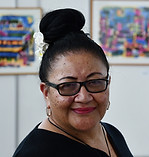
ISLAND FEMINISMS:
PLACE, JUSTICE, MOVEMENT
2021 Virtual Speaker Series
January 29

Marina Karides
University of Hawai’i at Manoa

Noralis Rodríguez-Coss
Gonzaga University
Co-founders of the Island Feminisms Project discuss their collaboration to bring together scholars and cultural practitioners in laying the first brick for the building of a new academic discipline bridging both island and feminist studies. Central themes include activisms, geographies, transnationality and feminist praxis.

Evyn Lê Espiritu Gandhi
University of California – Los Angeles
In 2006, in response to protests against military violence in Okinawa, the U.S. military announced the transfer of 8,000 Marines and 9,000 of their dependents from Okinawa to Guam. Although this announcement indexed the success of anti-military organizing on Okinawa, it did not result in a diminishment of transpacific militarization, but rather merely its lateral transfer to the unincorporated territory of Guam (Guåhan), home of the Indigenous Chamorro people. This paper proposes the need for feminist archipelagic analyses of transpacific American military empire, as well as feminist archipelagic tactics of island-based solidarities and resistance. It begins by charting historical and contemporary resonances between Okinawa and Guam in regards to settler colonialism, imperialism, and militarism. It then proceeds to read Collier Nogues' The Ground I Stand Is Not My Ground alongside Craig Santos Perez's from unincorporated territory series to propose a literary model of feminist archipelagic poetics, with a particularly emphasis on aesthetic practices of hypertextuality and intertextuality.
February 19

Jane Chang Mi
Scripps College
On March 1, 1954, Daigo Fukuryū Maru (Lucky Dragon Five), a Japanese fishing boat, was contaminated by nuclear fallout as a result of the United States’ thermonuclear test, Castle Bravo, in Bikini Atoll. The first ゴジラ movie was released in November 1954, as a direct response to this incident, as well as, the bombings of Hiroshima and Nagasaki. The kaiju (monsters) are a metaphor for nuclear weapons, the American militarization of the Pacific, and environmental disaster. In total, 32 Japanese films were made by Toho Co., Ltd. ゴジラ/ɡɒdˈzɪlə/ (2020) is a 96-minute single-channel video that layers all 32 films simultaneously, but with all scenes involving monsters and humans removed. This erasure mirrors the United States’ policies and actions as a settler and colonial nation, leaving a wake of destruction in both the film and reality. We are the monsters and the monsters are us.

Pefi Kingi
PacificwinPacific; NAVA - Niue Australian Vagahau Association
Victoria University, Victoria, Australia
My tattered copy of Lorde’s Zami (1982) attests to how much I was influenced by a fictionalised life story of a black theorist that lived half a world and lifetime away. This was followed by a diet of a few black women theorists and thought leaders who coloured the way I perceived my context of inter-dependence with Niuē My Motherland, Niuē in our adopted motu (country) Aotearoa New Zealand, and inter-relationships that shaped an awaiting dialogue. “Pulotu” is a discussion co-created to open up a space of dialogue towards a Niuē feminism. As with Zami, it is a combination of myth, history/herstory and biographical accounts. It posits “Pulotu” as an outlined Niuē form for the focused agenda. An interactive map, “Pulotu” is an invitation to co-design a framework that may work for Niuē peoples growing up in two societies, educated in four continents and traversing globally for a Bluer Pacific.
March 5 & 12

Directed by Justina Mattos
University of Hawai’i at Hilo
Set during the tumultuous period immediately following the fall of the traditional kapu system and during the arrival of the first American missionaries, The Conversion of Kaʻahumanu explores the relationship between Hawaiʻi’s Queen and the missionary women who seek to convert her to Christianity. Kaʻahumanu’s ultimate choice is made with the hope that it might serve to protect her nation during a time of catastrophic loss and immense change.
March 5: Act I followed by a brief Q&A including lead actress Desiree Moana Cruz, who played the role of Ka'ahumanu
March 12: Act II followed by a more extended discussion with playwright Victoria Nalani Kneubuhl.
April 16
Unearthing the Toxic Weeds of White Supremacy:
Reflections of a Pinay Scholar Warrior of Aloha in Decolonizing Social Work and Health

Alma M. Ouanesisouk Trinidad
Portland State University
This presentation shares a critical reflection of a Pinay (Filipina) Scholar Warrior of Aloha (love) in coalition building for equity among Indigenous Pacific Islander communities in a white dominating community/state. As a bridger and one that stands in solidarity with the PI communities, it begins by sharing the development and collective work of the Pacific Islander (PI) Coalition in Oregon. This coalition is a body linked to and in partnership with the County’s Health Department, and this scholar serves as an university partner. Her role aims to link, bridge, and partner in addressing health disparities and elevating PI voices. Its first major work was a data project utilizing a community based participatory action research model. The presentation also provides the scholar’s parallel work with the coalition’s partnership in decolonizing and Indigenizing social work curricula, practice, and community-based research. Collaborative feminist healing work with and among PI communities is implicated.
Issues of Resistance, Place, and Subversion:
The Prison Songs of Lili‘uokalani

Cynthia Morris
American Musicological Society (AMS)
Society for Ethnomusicology (SEM)
Queen Lili‘uokalani of Hawai‘i is known for writing the song “Aloha ‘Oe.” She ruled her nation and was overthrown and imprisoned by pro-American businessmen in the 1890s. This research is an historical musicology examination of songs composed by Lili‘uokalani during her 1895 incarceration at ‘Iolani Palace in Hawai‘i. The topic of this paper is the political and personal revelations in the Queen’s previously unexplored prison songs. The paper examines her utilization of music as a vehicle of communication, both informative and subversive, in a time of crisis. This research addresses the politicization and affect associated with the Queen’s music, specifically a holographic manuscript of “Aloha ‘Oe,” which was one of many pieces of music transcribed in prison for re-publishing. Lili‘uokalani was not allowed to keep a journal while imprisoned. In this paper, I argue that the Queen’s prison songs are a valuable resource and overlooked resource in decoding her activities and state of mind while imprisoned. The songs indicate that even while incarcerated, Lili‘uokalani was actively engaged in the fight for the sovereignty of the Hawaiian Islands.